This 3-year project is funded by the Vehicle Technologies Office within the Department of Energy and is a partnership between Sunnking Sustainable Solutions, Idaho National Laboratory, E Cyclers of Idaho.
This research project has two key goals.
We're moving these goals forward, together, using the strategies created by Sunnking for our collection events.
The first goal is to raise awareness about e-waste recycling, especially recycling of battery-containing devices.
The second goal is to enhance residential e-waste collection, which is currently a challenge across the US.
Sunnking has been in the electronics recycling business for more than a decade and has successfully organized large-scale outdoor collection events.
Learning from Sunnking’s experience, INL and E Cyclers have organized both indoor and outdoor events in Idaho to bring convenient electronics recycling to communities without the same legal requirements present in the state of New York.
According to the Department of Energy, only 17% of e-scrap was collected and recycled globally in 2019.
83% of electronic waste was discarded, which equals around $57 Billion in raw material value. Click here to learn more e-recycling facts.
According to the Department of Energy, only 17% of e-scrap was collected and recycled globally in 2019.
83% of electronic waste was discarded, which equals around $57 Billion in raw material value. Click here to learn more e-recycling facts.

Most people are aware of the benefits recycling brings to the environment. But did you know that recycling electronics also impacts the economy, public safety, and public health? Click here to learn more about these benefits and how you're able to help.

Most people are aware of the benefits recycling brings to the environment. But did you know that recycling electronics also impacts the economy, public safety, and public health? Click here to learn more about these benefits and how you're able to help.
What's in a battery, why are some rechargeable, and how can you tell the difference between them?
Click here to learn how batteries work, what battery types exist, and what resources are in batteries.
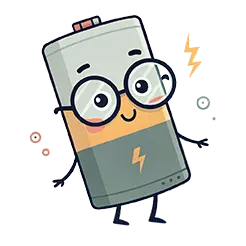
What's in a battery, why are some rechargeable, and how can you tell the difference between them?
Click here to learn how batteries work, what battery types exist, and what resources are in batteries.


People refer to electronic waste in different ways. Some call it e-waste or e-scrap. People also refer to it as end-of-life (EOL) electronics. You might even see it called waste electrical and electronic equipment (WEEE).
The many types of e-waste include everything from old cell phones and laptops to broken TVs and kitchen appliances.
Sunnking is working with INL to help residents and businesses recycle properly.
Our partnership protects sensitive data and keeps more electronics out of landfills.
E‑waste Definition:
E‑waste refers to any discarded or unwanted device with a plug or battery. Think of old flat‑screen TVs, outdated desktop computers, microwaves that no longer heat, and even the smartphone you replaced last year.
Instead of throwing these items away, you can bring them to a drop‑off location. You can also bring them to one of our free community recycling events.
Why Recycling Awareness Matters
· Environmental Benefits: Recycling recovers valuable metals and plastics from devices. This reduces the need for mining and manufacturing. Recycling also prevents harmful substances from leaking into soil and water.
· Data Security: We wipe and shred your hard drives in accordance with our certified data destruction services. This keeps personal and business information safe.
· Legal Compliance: In New York, electronics can’t go to the landfill. Recycling keeps you on the right side of state regulations.
· Community Impact: Some of our refurbished items find new life in local schools and nonprofits.
How to Recycle Your Devices
· Locate a Sunnking Site: Use our online locator tool to find the nearest recycling drop‑off location.
· Join a Free Event: We host weekend e‑waste collection drives. Check our upcoming dates and locations for your the most convenient option. These are the perfect way to recycle your old phones, laptops, TVs, and small appliances.
· Enterprise Solutions: Businesses can schedule pickups for large volumes of computers, servers, and other equipment. We track all assets with full chain‑of‑custody documentation from pickup to disposal.
Why Recycle E‑Waste?
· Environmental Impact: Reuse electronics and reclaim valuable materials—reducing mining and landfill waste.
· Data Security: Sunnking’s certified data destruction services ensure your hard drives and devices are wiped or shredded. Learn more about how we dispose of hard drives here.
· Regulatory Compliance: In New York, you cannot throw electronics in the trash. Proper disposal at a recycling center or event keeps you in compliance.
· Community Benefit: We partner with charities to help families and children in need. We also donate refurbished electronics to local causes.
· Resale: Through refurbishment we also give devices new life. This brings affordable, eco-friendly electronics to our community. We host One-Day Warehouse Sales and sell on e-Bay year round.
Services for Home and Business
· Residential: Bring household electronics cell phones, laptops, TVs, microwaves, etc. to our convenient drop‑off points or free events.
· Enterprise: From data‑center cleanouts to secure hard‑drive recycling, our IT Asset Disposition services handle everything with professionalism and transparency.
What Can Sunnking do for You?
Residential:
· Drop off your broken TV, old cell phones, laptops, microwaves, and more.
· Free e‑waste recycling event near you (check dates and locations)
· Data wiping on old desktop computers, old cell phones, and easy small appliance recycling.
Enterprise:
· IT asset recycling for bulk disposal of outdated computers, servers, and other equipment.
· Certified data security services, HDD recycling, and product destruction at scale.
· Asset tracking, reporting, and secure chain of custody from end-to-end.
· Wholesale purchasing of refurbished bulk equipment.
Common Questions
· Can I throw electronics in the trash?
No. New York law requires proper disposal at a certified facility. New Yorkers must dispose of all types of ewaste properly.
Even outside of New York there are many reasons not to throw away electronics.
· What is computer waste vs. e‑waste?
All computer waste is e‑waste, but e‑waste also includes TVs, microwaves, and other appliances.
· Examples of e‑waste?
Anything with a plug or a battery is e-waste. This includes phones, tablets, monitors, microwaves, gaming consoles. Basically, if it has a battery or a cord, it's e-waste.
· How do I get rid of an old laptop?
· You can drop it off at our recycling center.
· You can also bring it to a free event.
· For business assets, you can schedule a pickup for bulk IT Asset Recycling.
· What happens to my old devices?
We dismantle, separate, and send materials for processing at our recycling facility for reuse or safe disposal.
· Is there a cost?
Most residential drop‑offs and community events are free in New York due to regulations.
We are working with INL and E Cyclers of Idaho to help them host free recycling events in Idaho.



Recycling E-Waste has many benefits.
Let's break down some of the key advantages of recycling and reuse.
How does Recycling Help the Environment?
· Stops toxic metals from leaking into landfills.This protects people and natural resources like soil, groundwater, and air.
· Reduces the extraction of new raw materials by providing a renewable source for the materials in the electronics.
· Reprocessing e-scrap saves energy over new material production.
How does Recycling Help the Economy?
· Minimizes the consumption of critical minerals, many of which are rare and difficult to acquire in their raw form.
· Creates additional jobs through expansion of industries and resources.
· Supports a vibrant American recycling industry and refurbishing industry.
Public Health & Safety Benefits of Recycling:
It lowers the risk of damage to the kidneys, liver, lungs,and brain.
It does this by keeping harmful materials in e-waste out of landfills. Instead, it keeps these materials in the circular economy.
Why is Recycling Important?
Recovering materials and reprocessing them is vital because it conserves our planet’s finite resources and reduces the pressure on natural ecosystems.
But how does recycling decrease pollution?
Reusing materials like paper, metals, and plastics helps reduce pollution. It lowers the need to cut down trees, use water, and mine minerals.
Americans use non-renewable resources for 94 percent of their needs. If we don’t reuse paper, we would need to increase wood harvesting by 80 percent to meet demand.
The recycling rate of paper keeps this increase to only 20 percent. It also greatly lowers carbon emissions and significantly reduces the amount of waste from cutting down trees. [NIH]
This reduction in resource extraction helps save forests and water supplies. It also protects wildlife habitats and eco-diversity from the environmental impacts caused by logging and mining.
More Reasons to Recycle: Conserving Natural Resources & Energy Savings
Electronics recycling magnifies these benefits by recovering critical materials and slashing energy use in manufacturing.
Repurposing one million laptops saves enough energy to power over 3,500 U.S homes for a year. [US EPA]
For every million cell phones processed, e-recyclers recover about 35,000 pounds of copper. They also retrieve 772 pounds of silver, 75 pounds of gold, and 33 pounds of palladium. Rare resources that would otherwise require environmentally damaging mining to obtain.
Recovering electronic materials curbs pollution by avoiding the greenhouse gas emissions and chemical runoff associated with virgin electronics manufacturing. [US EPA]
Pros of Recycling:
Economic, Social, and Health Benefits
Beyond the environmental benefits, recycling programs drive social and economic benefits while safeguarding public health and reducing waste.
Donating or refurbishing used electronics helps schools, nonprofit groups, and low-income families get important technology. This action helps close the digital divide.
Proper e-waste processing is important for the circular economy of goods. Businesses that donate equipment can also claim tax incentives for their charitable contributions. [US EPA]
Recycling facilities manage harmful materials, such as lead,mercury, and cadmium, safely. This helps prevent pollution from those toxins leaking into soil and water.
This not only protects community health but also supports a robust network of certified electronics recyclers, strengthening both local economies and global sustainability.


Battery Usage
Sunnking and Idaho National Laboratory team up to clarify battery basics. From chemistry and everyday devices to safe handling and resource recovery.
We empower residents with our expertise and convenient service information.
Disclaimer: Sunnking does not accept all battery types. Please view our Acceptable Materials List or continue reading for more information.
Battery Meaning:
Batteries are storage devices for electricity. They allow us to create portable electronics ranging from EV Cars to the cell phone in your hand.
How Batteries Work
Every battery contains two electrodes, a positive electrode and a negative electrode. Also called an anode and a cathode, these are separated by an electrolyte. This electrolyte lets the charged particles flow.
When in use, ions travel from the anode to the cathode, creating an electrical current. Rechargeable cells reverse this process when connected to a power source, restoring energy for the next cycle.
Some batteries are single-use, while others allow for multiple charges. You can learn to tell them apart by learning these basic electrochemical concepts.
Different Types of Batteries:
Primary Cells (Single‑Use):
You will find these batteries most often in household gadgets and remote controls. Alkaline and zinc-carbon types provide steady voltage until they run out. They cannot safely undergo recharging without risking leakage or rupture.
Secondary Cells (Rechargeable): You will find these in devices like smartphones, laptops, and electric bikes. They include nickel-metal hydride (NiMH), nickel-cadmium (NiCd), lead-acid, and lithium-ion (Li-ion) chemistries. You can charge this type of battery many times. They usually have a higher initial cost. However, they have lower long-term expenses and a smaller environmental impact when paired with responsible recovery practices.
Common Devices Powered by Batteries
Every day, we rely on portable power for a wide range of personal and household gadgets.
Typical devices include:
· Laptops and Ultrabooks: From business notebooks to gaming computers, Li‑ion cells pack high energy in a slim package.
· Smartphones and Tablets: Our mobile devices use advanced Li‑ion or Li‑polymer packs for long screen time and fast recharges.
· Wearables and Fitness Trackers: Compact coin‑cell or button‑style batteries power health monitoring and GPS features.Cordless · Power Tools: NiMH, NiCd, and Li‑ion packs deliver the torque and runtime needed on the job site.
· E‑Bikes and Scooters: High capacity rechargeable modules enable eco‑friendly urban travel.
· Remote Controls and Clocks: Alkaline and zinc‑carbon cells remain ubiquitous in low‑drain electronics.
· Smoke Alarms and Security Sensors: Long‑lasting primary cells ensure safety systems remain active without frequent swaps.This variety illustrates how ubiquitous portable cells are—from critical safety devices to everyday entertainment.
Popular Battery Chemistries and Their Everyday Roles
Different kinds of batteries have their own chemical makeup. Understanding what's inside a battery can help you identify its potential uses.
Lithium‑Ion (Li‑ion) Family
· Lithium Cobalt Oxide (LCO): High energy density, powering smartphones and cameras.
· Lithium Iron Phosphate (LFP): Exceptional thermal stability, ideal for solar power storage and electric vehicles.
Lead‑Acid Batteries: Durable and cost-effective in car starters and backup systems.
NiMH & NiCd: Widely used in cordless tools, hybrid vehicles, and some medical devices.Each chemistry has trade‑offs in energy density, cost, and safety. Sunnking partners with Idaho National Laboratory to pilot new formulations that balance performance with community needs.
Resource Recovery and Reprocessing
At end of life, batteries still contain valuable metals. They can include lithium, cobalt, nickel, and lead, which some facilities can reclaim and reuse.
Proper collection and sorting are key: separate chemistries, remove external casings, and follow local guidelines.
Processing facilities employ mechanical shredding and advanced hydrometallurgy to extract these materials with minimal environmental impact.
Sunnking helps residents by offering convenient drop‑off points and offers transport coordination for businesses to ensure safe handling.
Battery Safety Best Practices Certified Products:
Use cells and chargers approved by recognized standards (e.g., UL 2054).
· Controlled Storage: Keep units in a cool, dry spot away from metal objects or flammable surfaces.
· Damage Protocol: Do not use swollen, punctured, or leaking batteries. Quarantine them and contact a professional.
· Charging Zones: Designate fire‑safe areas equipped with Class D extinguishers for bulk charging.
· Emergency Training: Ensure household or staff know how to respond to unwanted thermal events.
*** If a lithium battery fire occurs, move to a safe place and call 911.
Proper Battery Disposal in New York
New York State requires specific handling for spent lead-acid and rechargeable batteries to prevent environmental harm.
At Sunnking Sustainable Solutions we accept:
Rechargeable Dry Cell Batteries: Nickel-metal hydride (NiMH) and lithium-ion (Li‑ion) packs.
We do not accept:
· Damaged, defective, recalled, swollen, burned, or leaking batteries.
· Loose household cells (AAA, AA, C, D, button cells).
· Any battery containing liquid components.

INL and E Cyclers of Idaho have partnered with Sunnking Sustinable Solutions. We're working together to improve the future of electronics recycling collection. By sharing our e-waste recycling event model with INL, we're changing the future of responsible recycling across the United States.
Unlike in New York, Idaho does not have any e-waste laws. Our goal is to see if convenient recycling events work well without laws requiring the proper disposal of electronics. We are also collecting data using 5 to 10-minute surveys from participants before they leave the event.
Keep reading to learn more about our team-up.
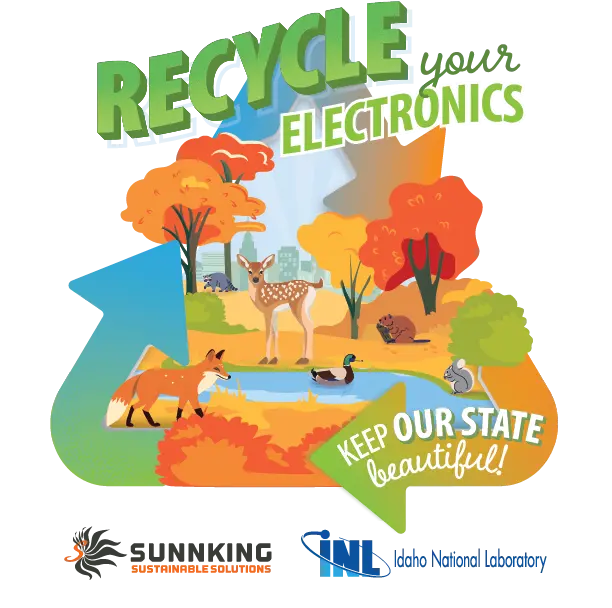
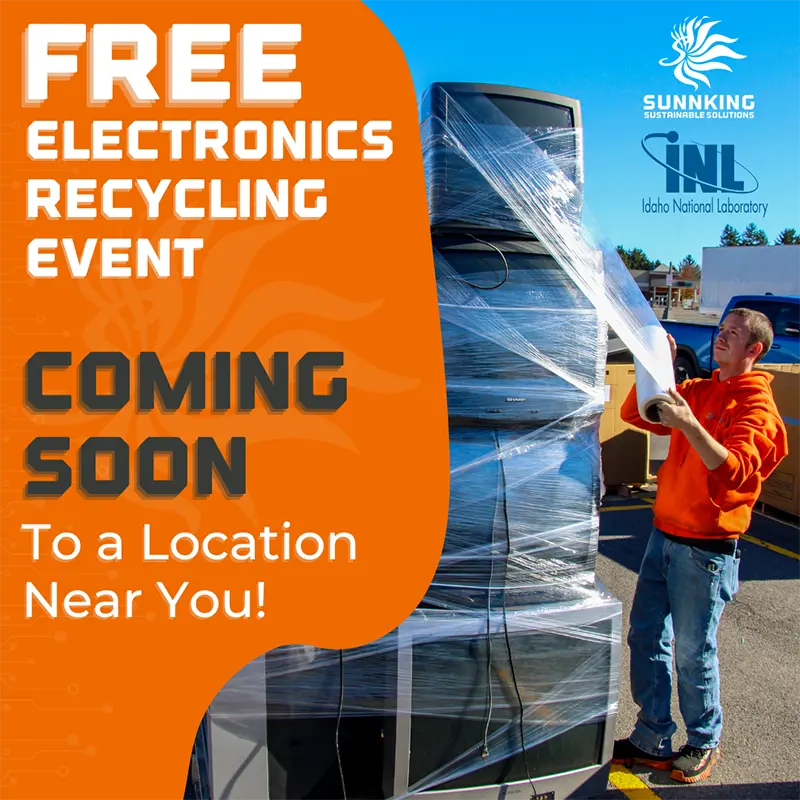
Free up room at home while supporting a cleaner planet.
Come to one of Sunnking’s upcoming residential drive-thru e-waste collection events. We'll be there rain or shine to recycle your used electronics.
In less than 10 minutes, you can dispose of your old tech.
Got more time than that?
Take our survey and help improve recycling for the future. Survey takers get a free tote and sticker.
Register. Drive Through. Drive Off. It’s that simple.

Sunnking and INL’s research looks at specific event data andparticipant surveys. They compare areas with regulations, like New York, tothose without, like Idaho. This helps improve and expand easy e-wastecollection models across the country.
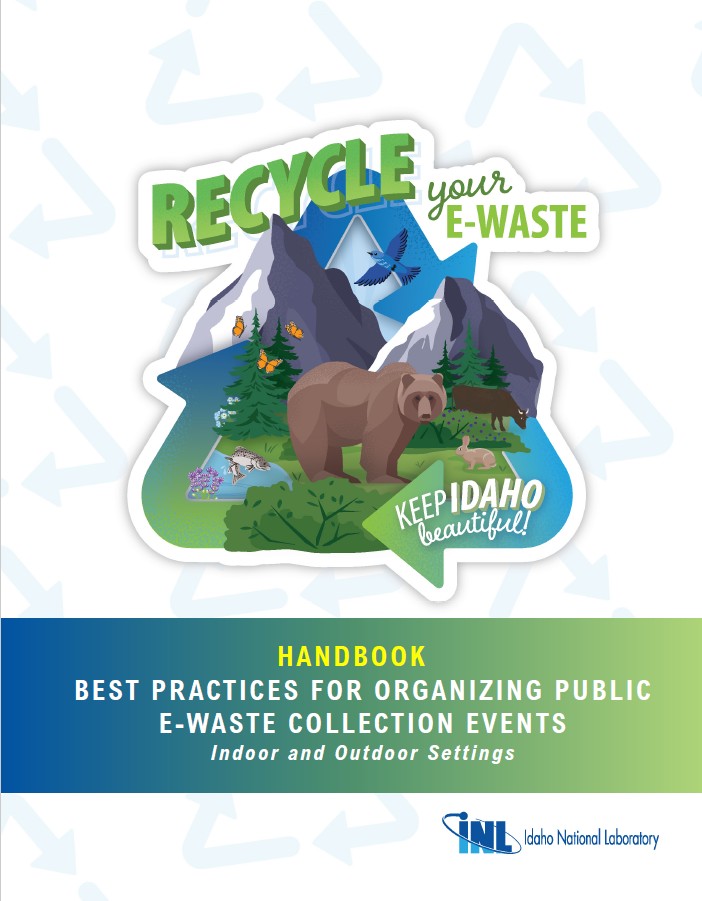


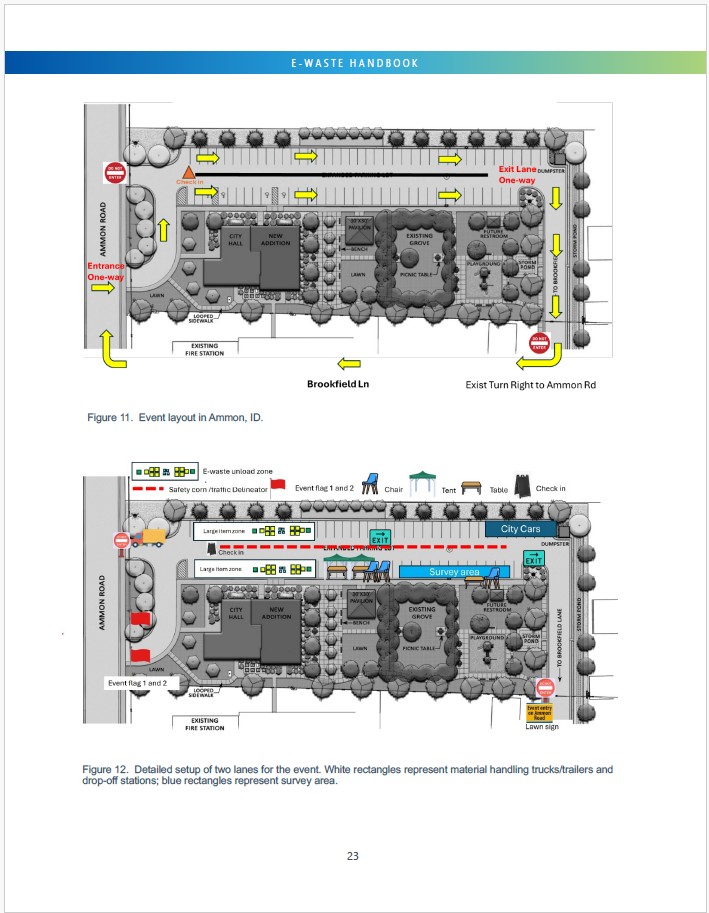
Best practices for organizing public e-waste collection events provides practical guidance for organizing effective e-waste collection events in both indoor and outdoor settings.
It covers essential steps such as defining goals, developing event descriptions, establishing organizing teams, acquiring resources, and evaluating post-event outcomes.
It also includes examples of event layouts, logistics, and lists of supplies for both indoor and outdoor events.
The handbook draws from Sunnking's extensive experience and has been verified by Idaho National Laboratory and E Cyclers of Idaho to ensure its applicability across various scales and locations.